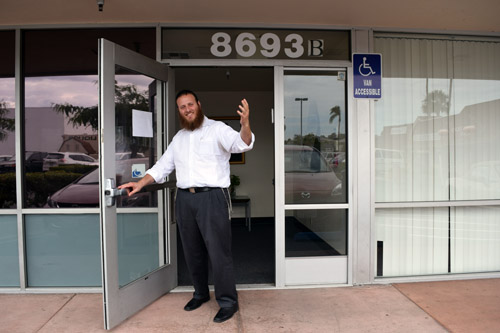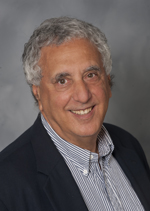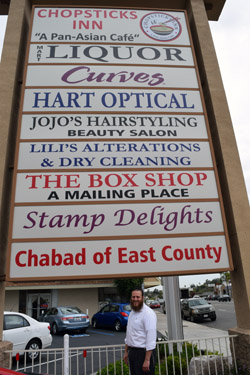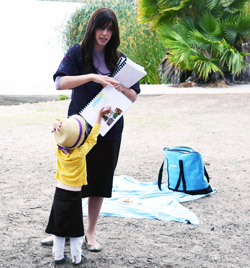
-42nd in a Series–
Exit 13A, Jackson Drive, La Mesa ~ Chabad of East County
By Donald H. Harrison


LA MESA, California – If I were to ask you what a pioneer looks like, perhaps you would describe him as a man wearing a coonskin hat, a buckskin jacket and pants, and moccasins. Maybe you would further imagine he’d have a horn of water at his side, a musket crossed over his chest, and a knife hanging from his belt.
Well, that’s one kind of pioneer. The kind I’m thinking about generally wears black pants, a white dress shirt from which tzitzit emerge and dangle below his waist, and a yarmulke or black hat on his head. This kind of pioneer is a Chabad shaliach, or emissary, whose job as a rabbi is to reacquaint unaffiliated Jews and their families with Jewish belief and practice, and to offer a menu of supplemental Jewish programming to Jews who already are affiliated with other movements.
Like the Jewish merchants of the 19th century who struck out for the newly forming communities of the American West, moving here and moving there until they found fertile ground in which to put down roots, so too do Chabad emissaries sometimes move here and there, hoping to find just the right place to ignite passion for Judaism among unaffiliated Jews in the neighborhood. One of the places that Chabad of East County found temporary domicile was at 8693-B La Mesa Boulevard in a small strip shopping center. Chabad even had its name on the shopping center’s marquis, but the demographics weren’t right. An insufficient number of Jews lived within walking distance of the space, and so Chabad held its services in such San Diego neighborhoods as San Carlos and Del Cerro. Having moved out of the La Mesa Boulevard space, the organization now is hoping to find a new, better located space, while continuing to conduct services in participants’ homes. Meanwhile, an office is maintained at 166 W. Park Avenue in El Cajon.
Meet Rabbi Rafael “Rafi” Andrusier, and his Rebbetzin, Chaya Smoller Andrusier. Together, they have staked out the urban portion of San Diego’s east county – specifically the eastern neighborhoods of San Diego, and the cities of La Mesa, El Cajon and Santee as an area in which to make their lives and to spread Jewish knowledge.
The Chabad movement studied this area before giving the couple the go ahead, aggregating its own list of Jews in the affected zip codes with another list supplied by the Jewish Federation of San Diego, and determining that there were at least 1,500 unaffiliated Jewish families in the area, well above the threshold for establishing a Chabad center, according to Andrusier.
At the same time, under the leadership of Rabbi Yonah Fradkin, the regional director of Chabad in San Diego County, the Andrusiers were scrutinized to determine whether their backgrounds as student emissaries and teachers in the Chabad movement indicated that they had the will and the follow-through to make a life-long commitment to the East County. You might say that the Andrusiers had an advantage going into this process: Chaya is the daughter of Rabbi and Rebbetzin Dovid and Rochel Smoller, longtime teachers at the Chabad Hebrew Academy in the Scripps Ranch neighborhood. Rabbi Fradkin had known the Smoller family for a long time, and was well aware that Chaya had come up through Chabad Hebrew Academy and went on to teach in a Chabad school in New York.
As Fradkin did not know Andrusier, he made inquiries about his record during various student assignments to countries such as Croatia, Peru, Greece, Russia and Australia, where Andrusier did such tasks as organizing seders, checking mezuzot to see if they were kosher, and inviting Jewish passersby to strap on tefillin and say a prayer – all part of Chabad’s belief that if a Jew can be persuaded to do one mitzvah, he or she will go on to others. One summer assignment brought Andrusier to San Diego as a student, working with Rabbi and Rebbetzen Mendy and Bluma Rubenfeld of Chabad of Poway on a campaign to get people to check their mezuzot, so of course Rubenfeld also was consulted.
Andrusier had grown up in Staten Island, a short trip across the Verrazano Narrows Bridge to Brooklyn and the headquarters of the Chabad movement in that borough’s Crown Heights section. His life revolved around the Chabad movement. The last Rebbe, Rabbi Menachem Mendel Schneerson, died while Andrusier was still a young boy, but he remembers those Sundays when the rebbe would hand out dollar bills to Jews who came from far and wide. “I also remember that after he had a stroke, he used to come out on the balcony” of Chabad’s world headquarters at 770 Eastern Parkway, known affectionately in Chabad circles simply as “770.”
While going to yeshiva, and participating in Chabad outreach programs, Andrusier decided that he wanted to be a shaliach, and let it be known that he would like to have a wife with similar ambitions. Through family connections, Rafi and Chaya were suggested for each other, but before they formally were introduced each family researched the child of the other – a process very similar to the one the couple later went through when they applied to become Chabad emissaries.
The reports about Chaya and Rafi were mutually satisfying, and so, in New York City, a meeting was arranged, in the lobby of a New York City hotel. By the time of their meeting, they knew quite a lot about each other, knew that both were serious about marriage, having a family, and establishing a Chabad Center. They talked and talked, and tired of sitting, they also strolled. Walking around, sightseeing, became a typical activity for their dating, during which conversations ranged from light topics to heavy ones.
Rafi didn’t drop to one knee and propose to Chaya – that’s not the way things are done in the Chabad movement. Before the Rebbe died, couples would go to him and ask for his blessing for their marriage. If he gave it, they were engaged; if not, some remedial activity might be necessary. Following the Rebbe’s death, couples went to visit his gravesite or Ohel at a cemetery in Queens. When they emerged from the cemetery, feeling they had the late Rebbe’s approval, they would announce their engagement.

In 2010, about 3 ½ months after their visit to the Ohel, Rafi and Chaya were married, a joyous occasion they celebrate on its Hebrew date which coincides with the last day of Chanukah. Having visited the Poway area, and also having a brother, Elly, who is a Chabad rabbi in Irvine, California, Rafi did not require much convincing to move to San Diego, assuming approval for a new Chabad House could be obtained.
While it would not be financially easy to support themselves while simultaneously raising money for a Chabad Center and programming, the Andrusiers had an advantage that many other shlichim do not enjoy. Her capabilities being well known, Chaya was appointed as a pre-school teacher at the Chabad Hebrew Academy, working five half-days per week and assuring that the couple had some guaranteed salary.
Chabad Centers do not receive subsidies from either the national or the regional headquarters; it is the duty of the family to develop their own resources through donations and programming. When the Chabad of East County headquarters were in the small shopping mall at 8693-B La Mesa Boulevard, Shabbat services were held there once a month (and on another Shabbat each month at the Andrusier home in the San Carlos section of San Diego). After-school Hebrew classes were conducted once a week; and adult discussion classes were held one evening a week. At the Chabad Center, as well as at offsite locations, individual Jews joined Andrusier for 1:1 studying. Andrusier delights in discussing Torah and the principles of Judaism with adult students, among them, retirees who, after full careers, are interested in reconnecting with their religious heritage.
The distance between the shul in La Mesa and the Andrusier home in San Carlos made the arrangement less than ideal. Because it was too far to walk from their home to the shul on Shabbat, the Andrusiers had to make arrangements to stay nearby. They didn’t relocate their home closer to the shul because San Carlos, and not La Mesa, is in the middle of their target demographic area.
There already are non-Chabad Jewish congregations in the San Carlos-Del Cerro areas, including Young Israel of San Diego, a small Orthodox congregation to which Andrusier, himself, sometimes walks to services; Tifereth Israel Synagogue, a large Conservative congregation; and Temple Emanu-El, a substantial Reform congregation.
Andrusier said the intention is not to compete with these synagogues, but rather to supplement current community programming.
One of the first things he did upon arriving in the area, he said, was to introduce himself to Rabbi Leonard Rosenthal, the spiritual leader of Tifereth Israel Synagogue. The two rabbis have been studying Torah, Talmud and Hassidism together in Rosenthal’s office, aware that while there are differences between their two movements, they have much more in common as fellow Jews.
More recently, Andrusier said, he participated in a luncheon meeting sponsored by the Jewish Federation of San Diego County which also included Rosenthal, Rabbi Deborah Marcus of Temple Emanu-El, and Rabbi Avram Bogopulsky of Beth Jacob Congregation, whose College area synagogue lies south of the boundary of Andrusier’s East County area. Rabbi Chaim Hollander of Young Israel of San Diego also was invited to the luncheon but his duties as a teacher at Soille San Diego Hebrew Day School precluded his attendance.
Among ways that Andrusier has attracted unaffiliated Jew to meet with him on a 1:1 basis has been to walk through residential and commercial neighborhoods looking for doorposts with mezuzot. He will knock, introduce himself, and explain that Chabad’s mission is to bring greater understanding of Judaism, without charge or need for membership, to any Jew who is interested.
Additionally, he said, whenever he hears of a Jew throughout the rural portions of the East County – whether that be Crest, Alpine, Blossom Valley, Pine Valley, or even towns and venues within neighboring Imperial County – he will make house calls.
The rabbi and rebbetzin enjoy outdoor ceremonies with school children, and have scheduled events at such locations as Mission Trails Regional Park, Lake Murray, the San Carlos Recreation Center, and Grossmont Shopping Center, where they conduct an annual lighting of the Hannukiah. The Andrusiers have three young children of their own, who, in 2015, were all under 5 years of age.
Public activities—along with a large menorah that sits on the lawn in front of the Andrusier home – arouse curiosity and start a process to bring more Jews back into the fold, Andrusier says. The rabbi also serves as a mashgiach (kosher supervisor) for various caterers and is often called to officiate at life cycle events.
The idea, he said, is not to build a new synagogue, but rather to connect and relate to every Jew regardless of level of knowledge or observance.
*
From Jackson Drive exit head south on Jackson to La Mesa Boulevard and turn right. The Chabad Center was on the left side, just past Glen Street.
Next: A mini-monitor for your heart
*
Harrison is editor of San Diego Jewish World. You may comment to him at donald.harrison@sdjewishworld.com, or post your comment on this website provided that the comment is civil and that you identify yourself by full name and city and state of your residence.